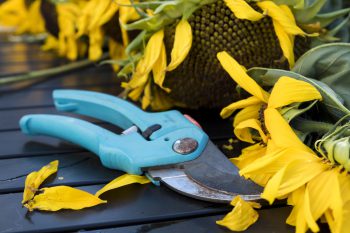
Get your garden tools ready for Spring
Spring arrives this year on March 20 at 5:37 a.m. Eastern Time, according to my new best book, The Old Farmer’s 2021 Almanac. It’s also predicting more rainfall than normal in the Southeast in spring, but that’s not always a bad thing.
Although March is too early to start your spring and summer gardening, there are still plenty of chores to do before the warm weather arrives. It’s general knowledge that here in Northeast Georgia, the date of the last frost is April 15. Sometimes I push the envelope and put out our tomatoes, plant beans and peppers just a few days early.
As for those chores, when was the last time you cleaned, sharpened and oiled your hand tools? With at least a half-dozen hand pruners for my roses, for some reason, I can never find a sharp pair.
You can sharpen hand-pruners, loppers and shovels yourself and frankly, that’s what I’ve begun doing. I haven’t been able to find a good retail store that can sharpen them to my liking.
Enter YouTube, where there are plenty of videos, some simpler than others. Google, then make your choice. Most recommend spraying the pruner blades with WD-40 and rubbing them with steel wool first to remove sap, grime and gunk. Then use your tool of choice. Some require sharpening stones; others promote using files.
To prolong the life of your garden tools, clean them after every use. It doesn’t take long to rinse them off, use a barbecue brush to remove clumps of clay and dirt, and dry them with an old towel or T-shirt. Then spray them with a bit of vegetable oil. Keep a can of non-stick spray near your storage area.
Before your first mow – if you didn’t do this last fall – clean your lawn mower. The blades and underside may be caked with last-year’s grass clippings. If so, use a wire brush then spray with water and dry. Your lawn will thank you if you also take time to sharpen the blades. Again, YouTube to the rescue.
Once your pruners are sharpened, clean up and cut back any perennials, such as dinner-plate hibiscus, angel trumpets and plants such as cone flowers, scraggly lavender, black-eyed Susans and others that have left last year’s stems. You can also clean up spent blooms from your panicle hydrangeas.
However, do not prune mophead hydrangeas, forsythia “yellow bells,” azaleas or gardenias. If you do, you’re cutting off this season’s blooms. Wait until after they’ve blossomed to do your pruning of these plants.
Then, look at your vegetable garden. Is it ready for your seedlings and the seeds that you’ll be direct-planting, like carrots, beans and squash? Pull any weeds; don’t just till them into the soil or you’ll be plagued by weeds all season.
Add composted material, chopped leaves, perhaps a couple of bags of quality garden soil. Sprinkle some 10-10-10 fertilizer and turn it in thoroughly. Cover the beds with several layers of newspaper, weighted down with a light layer of mulch. This will prevent any weeds from spouting over the next month until you’re ready to plant.
Take advantage of March’s periodic warmer sunny days. By the time you’re ready to start growing vegetables, all you’ll need to do is dig a few holes to plant your seedlings around mid-April. Your spring/summer garden will be off and running and before you know it, you’re harvesting home-grown tomatoes, and other scrumptious vegetables.







